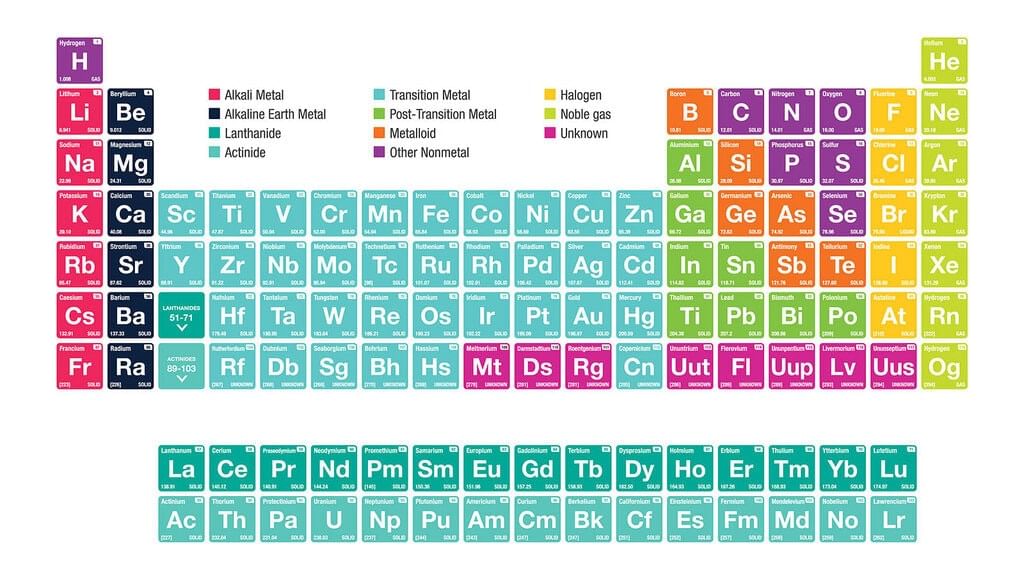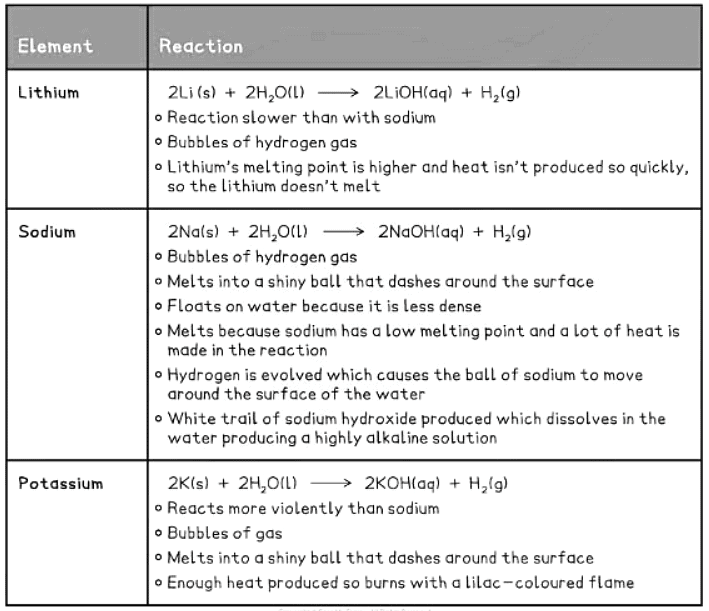Class 10 Exam > Class 10 Notes > Chemistry for GCSE/IGCSE > Group I Properties
Group I Properties | Chemistry for GCSE/IGCSE - Class 10 PDF Download
The Group I metals
- The Group I metals are also called the alkali metals as they form alkaline solutions with high pH values when reacted with water
- Group I metals are lithium, sodium, potassium, rubidium, caesium, and francium
- They all contain just one electron in their outer shell
Physical properties of the Group I metals
- Group I metals exhibit softness and are easily cut, with their softness and density increasing further down the group (though exceptions like sodium and potassium exist regarding density).
- Freshly cut surfaces of Group I metals display shiny, silvery appearances.
- They possess the ability to conduct both heat and electricity.
- Group I metals generally have low melting points and densities compared to other metals, with their melting points decreasing as one moves down the group; some may even melt under hot conditions.
Question for Group I PropertiesTry yourself: Which property of Group I metals increases as one moves down the group?View Solution
The alkali metals lie on the far left-hand side of the Periodic Table:
Chemical properties of the Group I metals
- Group I metals exhibit high reactivity with both oxygen and water vapor in the air, necessitating their storage under oil to prevent reactions.
- When exposed to water, Group I metals undergo vigorous reactions, yielding alkaline metal hydroxide solutions along with hydrogen gas.
- The reactivity of Group I metals increases progressively as one moves down the group, prompting restrictions in schools where only the first three metals are permitted for demonstrations.
Reactions of the Group I metals with water:

Predicting the Properties of Group I Elements
- Understanding how the top group I elements react helps in anticipating the behavior of elements lower in the Group I.
Properties of other Alkali Metals (Rubidium, Caesium, and Francium)
- As we move down the alkali metal group, including rubidium, caesium, and francium, their reactivity intensifies compared to lithium, sodium, and potassium.
- Among these metals, lithium is the least reactive at the top, while francium, found at the bottom, is exceptionally reactive.
- Predictions involving francium can be challenging due to its scarcity and radioactivity.
- For instance, when considering reactions with water:
- Predicting the Reaction with Water:

- You can also observe other properties such as boiling point, melting point, and density of Group I elements to predict whether other properties are likely to be larger or smaller descending down the group.
- Consider examining boiling point, melting point, and density of Group I elements to anticipate the variations in other properties as you move down the group.
Question for Group I PropertiesTry yourself: Which of the following statements is true about the reactivity of Group I metals?View Solution
The document Group I Properties | Chemistry for GCSE/IGCSE - Class 10 is a part of the Class 10 Course Chemistry for GCSE/IGCSE.
All you need of Class 10 at this link: Class 10
|
72 videos|162 docs|61 tests
|
FAQs on Group I Properties - Chemistry for GCSE/IGCSE - Class 10
| 1. What are the Group I metals? |  |
Ans. Group I metals are the elements located in the first column of the periodic table, including lithium, sodium, potassium, rubidium, cesium, and francium.
| 2. What are the common properties of Group I metals? |  |
Ans. Common properties of Group I metals include low melting and boiling points, high reactivity with water, forming alkaline solutions, and having one electron in their outermost shell.
| 3. How do Group I metals react with water? |  |
Ans. Group I metals react vigorously with water to form metal hydroxides and hydrogen gas. The reactivity increases down the group from lithium to francium.
| 4. Why are Group I metals stored under oil? |  |
Ans. Group I metals are stored under oil to prevent them from reacting with moisture and oxygen in the air, which could lead to corrosion and degradation of the metal.
| 5. What are some practical applications of Group I metals? |  |
Ans. Group I metals have various applications, including in the manufacturing of batteries, fireworks, streetlights, and pharmaceuticals. Sodium and potassium compounds are also used in fertilizers and food preservation.
Related Searches















